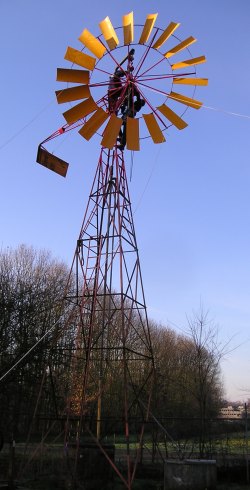The Diever
The Diever 450 is a water-pumping windmill designed by WOT in 1987 as a successor of the 12PU500 (also designed by WOT in 1979). The Diever 450, or 18PU450, is named after a prominent WOT member, Albert (Appie) Diever. A prototype of (t)his mill was erected on the WOT demonstration terrain in 1987. In 1990 a Technical Report of the Diever 450 was issued and new drawings were made. The former safety mechanism was changed to an inclined hinge main vane with sidevane. However, the prototype on the test field was not changed. Instead, in 1991, approximately 10 Dievers were installed in Bolivia according to these new drawings as a tryout. The feedback-report of this tryout, which was received in 1992 was positive. In 1993 the windmill on the WOT test field was equipped with a hinged side vane with an eccentric rotor. For this reason, the head, the tail with vane, and the transmission had to be altered. The complete structure was repainted and new wooden bearings were fitted. Several graduates have been working on finishing drawings of the rotor, the tail, and the tower. Also, a study about optimising the transmission was carried out. Parallel to this, a thorough (comparing) survey was made to verify the applicability of Diever 450 regarding technical, producible, and commercial aspects. In 2010 Diever 450 was built by Pulchowk Engineering Campus, Nepal. In 2016 Diever 450 on the test field needed another layer of paint. It was decided to equip the mill with rolling bearings, according to drawings from 2004, the main reasons being reducing friction and maintenance. In 2017 fabrication drawings of the Diever 450 were completed. During the spring of 2018, permission was granted to fabricate one Diever 450 in Rayton, South Africa. That decision triggered the WOT to issue a ”new” technical report of the Diever 450, with all changes made since 1990, which can be found here.

